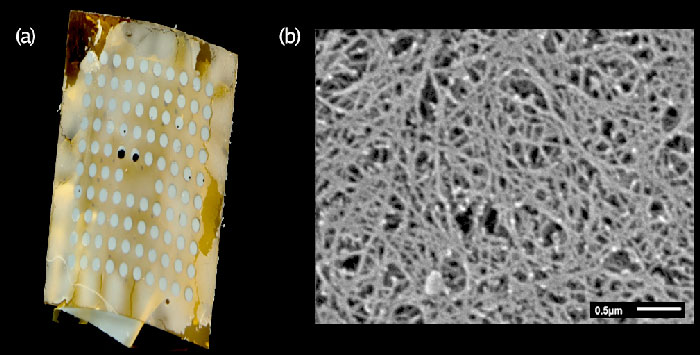Gary Grim | 17-ERD-110
Overview
We investigated the feasibility of using an intense short-pulse laser to duplicate plasma conditions where astrophysically relevant charged-particle reactions occur. We have shown that unstructured foams comprised of 100-nm-scale ligaments and voids, irradiated by an intense short-pulse laser, result in an isotropic explosion of the material producing a near-solid-density plasma having a multi-temperature distribution of ion kinetic energies. The endpoint energies extend out to 250 keV, and a substantial portion of the ions have a temperature approaching 50 keV. Initial experimental tests were conducted using deuterated aerogel foams irradiated by an 851-nm laser. Though more experimental effort is required to produce significant quantitative results, per-shot yields of neutrons appear to have been observed, which is in agreement with model predictions.
Background and Research Objectives
Our understanding of a wide range of astrophysical phenomena, including stellar energy production and nucleosynthesis (the process that creates new atomic nuclei from pre-existing nucleons, protons, and neutrons), depends on a precise knowledge of charged-particle nuclear reactions that occur at very low rates (Arcones et al. 2017, Mumpower et al. 2016, Mendoza-Temis et al. 2016, Tanvir et al. 2017). Though models exist, measuring these reactions under astrophysically relevant conditions has been challenging: Low-energy accelerator-based measurements don't produce statistically significant data samples (Bertulani and Kajino 2016), which leaves open the accuracy of screening corrections from a cold solid-density target applied to a plasma. Our goal was to develop a new platform that would provide a microscopic volume of near-solid-density plasmas with ion temperatures of tens of millions of degrees, where measurable reaction products would be created at conditions similar to those found in astrophysical objects such as stars. Our experimental results appear to validate existing models.
As previously described by R. A. Snavely (2000), target-normal sheath acceleration (TNSA) is the dominant process by which ions are accelerated in the interaction of an intense sub-picosecond laser pulse with solid matter. Laser-generated relativistic electrons create an electrostatic sheath (a high-density plasma layer) directed at an angle normal to the target surface, lasting several times the laser-pulse duration. In experiments where intense, short laser pulses irradiate solid micrometer-thin foils, TNSA was found to accelerate ions to tens of MeV/µm (Macchi et al. 2013). We explored using the TNSA mechanism to explode unstructured near-solid-density nanofoam targets (see figure) protected from direct laser irradiation by a thin, solid layer of metallic material. Flooding the target with electrons generated via the laser interaction rapidly led to ionization and accelerated the ions at angles normal to the surfaces of the nanometer-scale ligaments that made up the foam, turning it into a uniform isotropic plasma within hundreds of femtoseconds. When deuterated carbon was used for the target material, substantial charged particle reactions occurred, resulting in significant neutron yields.
Impact on Mission
By developing new capabilities for obtaining nuclear data in regimes previously inaccessible, this work supports the Laboratory's core competency in high-energy-density science, as well as DOE goals in energy and nuclear security, which rely on an understanding of matter under extreme conditions of temperature and pressure, such as those found in the fusion reactions that power the stars. If properly developed, this platform could enable physical cross section measurements that are relevant for astrophysics, as well as providing better data for use in applications such as inertial confinement fusion, where the probability of deuterium-tritium fusion in a hot plasma-screened environment can be more accurately determined. There are numerous other potential programmatic applications of this platform, including the prospect of studying other nuclear reactions in a hot reacting plasma. For example, it may be possible to study neutron reactions such as (n,2n) or fission by creating deuterated foams targets that would allow the D(d,n) 3 He to produce an energetic fluence of neutrons that would strike the other elements used to make the foam and produce reactions of interest.
Conclusion
Going forward, further effort should be made to take this platform from an interesting academic study to a viable platform for making quantitative measurements. Most notably, follow-up experiments should be conducted to better characterize the experimental conditions needed to reliably produce the desired reactions. In addition, the goal of further development should be to provide the key information needed to make a nuclear cross-section measurement, including understanding the chronology of the reaction process, the size of the reacting volume, and the distribution of the ion kinetic energies within the reacting volume.
References
Arcones, A., et al. 2016. "White Paper on Nuclear Astrophysics and Low Energy Nuclear Physics Part 1: Nuclear Astrophysics." Progress in Particle and Nuclear Physics 94(C): 1–67. doi: 10.1016/j.ppnp.2016.12.003.
Bertulani, C. A. and T. Kajino. 2016. "Frontiers in Nuclear Astrophysics." Progress in Particle and Nuclear Physics 89: 56–100. doi: 10.1016/j.ppnp.2016.04.001.
Macchi, A., et al. 2013. "Ion Acceleration by Superintense Laser-Plasma Interaction." Review of Modern Physics 85(2). doi: 10.1103/RevModPhys.85.751.
Mendoza-Temis, J. J., et al. 2016. "On the Robustness of the r-Process in Neutron Star Mergers Against Variations of Nuclear Masses." Journal of Physics Conference Series 730(1). doi: 10.1088/1742-6596/730/1/012018.
Mumpower, M. R., et al. 2016. "The Impact of Individual Nuclear Properties on r-Process Nucleosynthesis." Progress in Particle and Nuclear Physics 86: 86–126. doi: 10.1016/j.ppnp.2015.09.001.
Snavely, R. A., et al. 2000. "Intense High-Energy Proton Beams from Petawatt-Laser Irradiation of Solids." Physical Review Letters 85, 2945–2948. doi: 10.1103/PhysRevLett.85.2945.
Tanvir, N. R., et al. 2017. "The Emergence of a Lanthanide-Rich Kilonova Following the Merger of Two Neutron Stars." The Astrophysical Journal Letters 848.2: L27. doi: 10.3847/2041-8213/aa90b6.
Publications and Presentations
Grim, G. P., et al. 2018."Generating Near Solid Density Ion Distributions Using Intense Short Pulse Lasers." 60 th Annual Meeting of the APS Division of Plasma Physics, Portland, OR, November 2018. LLNL-ABS-753745.
Wilks, S. C., et al. 2017. "In situ Neutron-Based Diagnostic of Solid Density Plasma and MeV Ion Beams Created by Collisionless Shocks." 47th Annual Anomalous Absorption Conference Florence, Oregon, June 2017. LLNL-PRES-732672.






